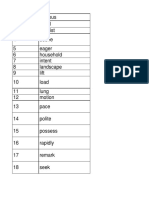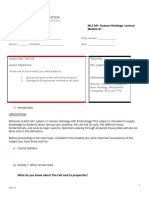FORENSIC SCIENCE
The word Forensic emanated from Latin word forum which means ‘’the market place or an open
or public place ’’. In the olden Roman society justice was administered to culprits in the market
place to serve as deterrence to others and disgrace to the family of the culprits.
Forensic Science (FS) is the application of scientific evidences for the purpose of law. Or
application of science to the administration of law. FS involves the collection, preservation and
analysis of evidence suitable for prosecuting an offender in the court of law. Any natural science
can be a forensic science because almost all science can contribute to solving a crime or
evaluating a civil harm. In fact, with few exceptions, forensic sciences are not different in what
they study than traditional sciences. The only difference is that forensic scientists apply the
methods and techniques of established sciences to solve legal matters.
A forensic scientist is first and foremost a scientist. When scientific knowledge is used to help
lawyers, juries, and judges understand the results of scientific tests, the scientist becomes a
forensic scientist. The work of a forensic scientist is intended to be used in court of law and
because scientific evidence can be very powerful, the forensic scientist must be accurate,
methodical, detailed, and above all, unbiased.
Forensic scientist is involved in the collection, preservation and analysis of
scientific evidence during the course of an investigation. While some forensic scientists travel to
the scene of the crime to collect the evidence themselves, others occupy a laboratory role,
performing analysis on samples brought to them by other individuals.
The main areas of forensic science follow.
Forensic anthropology: It the application of the anatomical science of anthropology and its
various subfields including forensic archaeology and forensic taphonomy in a legal setting.
Estimation of age, sex, race and stature can easily be done.
Criminalistics is the application of forensic science to criminal matters. Criminalist and forensic
scientist are the same.
Forensic engineering is the investigation of property loss and injuries related to failure in
materials, components design and structures. The goal of forensic engineering is to determine the
cause of a failure.
1
�Forensic odontology or dentistry is the application of dental evidence to both criminal and civil
law. It involves the handling, examination and evaluation of dental evidence in a criminal
context.
Forensic pathology is the pathology that focuses on determining the cause of death by examining
the corpse. A post mortem examination is perform by a medical examiner or forensic pathologist,
during the investigation of criminal law cases and civil law cases.
Forensic entomology, this usually involves the identification of insects and other arthropods
associated with human remain as an aid to determining the time and place of death. Also as the
study of arthropods especially insects, associated with crime and other aspect of court and
judicial system.
Forensic Toxicology is the science of detecting and identifying the presence of drugs and poisons
in body fluids, tissues, and organs for the purpose of determining their influence on human
behaviour. It can also be regarded as a multidisciplinary field involving the detection and
interpretation of the presence of drugs and other potentially toxic compound in the bodily tissues
and fluids.
Psychiatry and behavioural science (Forensic psychology).
Forensic psychology is a specialty in professional psychology characterized by activities
primarily intended to provide professional psychological expertise within the judicial and legal
systems.
Significant of Forensic Science
(i) It can be used to identify and incriminate suspects by studying finger print, blood
types or DNA profiling of such individuals.
(ii) It can be used to proof or disproof claims made by suspects about an incidence. For
example if a suspect claims he was not at the crime scene but unique fibres, debris, or
even fungal spores turn up on the suspect clothes.
(iii) FS is the key to establishing the singularity of crime scene evidence to nail the
suspects or exonerate the suspects.
There are many areas covered by forensic science. The operation of the biochemist in
forensic science may be either absolute or comparative. The first duty is to identify
2
�absolutely and secondly to compare with known specimen. The biochemists work
involves separation, identification, and quantitation. He has to carry out analysis of
contact and trace materials and comparison of the materials found in possession of a
suspect with control materials from the scene of the incident or crime.
Among the forensic science duties (specialties) include
i) Toxicology eg extraction of poisonous from tissue
ii) Alcohol in blood or urine
iii) Analysis of hard drugs
iv) Blood grouping
v) Contact or trace materials
vi) Question documents
vii) Counterfeiting
viii) Pathology
ix) Ballistics
x) Doping
xi) Drugs analyses
3
� COLLECTION, PRESERVATION AND FORWARDING OF MATERIALS OF
FORENSIC INTEREST.
Materials of forensic interest are also called exhibits or exhibit of production. The aim of
collection and preservation is to ensure protection and safe transit so that the expert may receive
the sample as nearly as possible in the condition in which it was first found.
In selecting the type of wrapping or containers suitable for any given purpose, the first essential
is that whatever is used must be scrupulously clean and dried, so as to avoid transfer of
contaminating materials to the exhibit. Containers should be tight and depending on the nature of
the material strong enough so that they will not break in transit. Each item should be clearly
marked and separately packed. Bottles and other glass vessels, which contain liquids, should not
be packed with other materials since they may break and contaminate other things. Objects
bearing finger or glove prints should be packed so that they do not come in contact with each
other or the package sides. Original tool marks should be protected from contamination and
moisture. The marks may be protected from rusts by a light film of oil if transfer of trace
material is not indicated.
Clothing containing dry stains of blood, seminal fluid i.e should be warped separately and in
such a way that the stains are not rubbed of wet clothing should be dried by a fan or ordinary air
(drought). If packed wet it may become putrefied or moldy and thus become unsuitable for
analysis.
Garments containing hair should not be allowed to come in contact with other garments, which
contain hair. Firearms should be rigidly fixed inside a wooden container without further
wrapping. Cartridges cases and bullets should be packed separately and with soft cushioning
material e.g cotton wool. Materials such as hair, fibres, glass fragments, flakes of paint may be
enclosed in glossy paper folds and secured by adhesive viscose tape. If these are found to be
adhering to some small objects e.g blood crusts of weapons, the object it is adhering to should be
brought to the laboratory with hairs or fibres remaining in situ. Forceps should always be used in
4
�picking up hairs or fibers. Tablets shodul be carried in vials or pillboxes and supported on all
sides with sterile absorbent cotton. Charred (burnt) materials should be parked in strong boxes
and supported on all sides with absorbent cotton. A charred paper may also be parked in a plastic
paper bag blown up and securely packed. Charred materials may also be preserved with soluble
nylon commonly called calaton CA.
For liquids, narrow necked bottles fitted with glass stoppers are preferable for most liquids
including acids and inflammable liquids such as petrol, benzene and paraffin. Where the sample
is an alkaline liquid such as caustic soda or caustic potash solution, a glass stopper is unsuitable
and should be replaced by an accurately fitting rubber bung. wide mouth glass jars fitted with a
ground glass stoppers and with a capacity of not less than 3pt are the most suitable containers for
large volumes of materials of fluid or of semi-fluid in nature e.g. vomits, stomach washing,
intestinal contents.
Collection, preservations and forwarding of biological samples for medicolegal autopsy
cases.
Collection of proper autopsy specimen is an essential part in the process of toxicology case work.
The improper collection of specimen can greatly alter or negate chemical and toxicological
analysis hence adhering to the standard methods of biological specimen collection procedures for
toxicological analysis is helpful for the forensic pathologist and forensic scientists. The
following guidelines are necessary in the selection of appropriate specimens of the body fluids
and tissue for postmortem biochemical and toxicological analysis. It is important to note that
after death there is a rapid change in the cellular level biochemistry due to analysis. Drugs and
other poisons may be released from the binding sites in the tissues and major organs. The
unabsorbed drugs may diffuse from the stomach hence care is taken in selection of blood and
tissues sampling sites. Ideally the samples for toxicological or biochemical analysis should be
collected before the postmortem but some of the samples may be difficult to obtain since the
body has to be opened. The samples to be collected can be grouped into biological fluids and
biological tissues.
5
�Biological Fluids: The biological fluids to be collected for medicolegal autopsy cases include
blood, urine, bile, cerebrospinal fluid and other body fluids.
1. Blood: Blood specimen should be obtained when blood is available. Blood is used as a
reference sample for identification in unidentified cases and also for toxicological
analysis. Peripheral blood concentration has been shown to be more reliable for
toxicological analysis than the conventional heart blood. Therefore in all suspected
poisoning cases and all cases of unknown causes of death a femoral blood specimen
should be collected. it can be collected with a needle and syringe or by puncturing the
femoral vein after exposing the vein by dissection and clamping or ligating it proximal to
the collection site. (Note: The most satisfactory way of obtaining a venous blood sample
is venipuncture of the femoral vein by direct puncture in the groin before autopsy
begins). About 20ml of blood is sufficient and it is preserved in sodium fluoride (of
concentration 10mg/ml) and potassium oxalate (30 mg/ml) of blood concentration in a
fresh wide mouthed glass container of capacity 30ml with screw cap (or use universal
container).
the glass should be made of amber glass to inhibit photo-degeenration. Rubber or cork
caps should be avoided. Sodium fluoride protects blood from postmoremtm changes such
as bacterial production of ethanol or other alcohols. It also helps to protect other labile
drugs such as cocaine, nitrazepam, clonazepam from degradation.
2. Urine: Urine specimen is important in screening for unknown drug or poison especially
in substance of abuse since the concentrations are generally higher than in blood and
some metabolites may also be present in the urine. urine samples are also valuable in the
quantitative analysis of alcohol and where there is uncertainty over the validity of blood
specimen. Urine can be collected by catheter (before conducting the autopsy) or
suprepublic puncture with a syringe and needles. The needs is gently aspirated while
introducing it. Urine can be best obtained during autopsy after exposing the abdomen by
puncturing the fundus of the bladder with syringe and needles. Collected urine is
6
� preserved in sodium fluoride (10mg/ml) in a 30ml glass container with a screw cap. A
sample of 20mml is sufficient for toxicological analysis.
3. Bile: Bile is useful in estimating drugs which are concentrated by the liver and excreted
into the galls bladder such as opiates, acetaminophen (paracetamol) etc. Bile can be
collected directly by incising the gall bladder into a glass bottle. Bile fluid is viscous
hence it is difficult to suck it with needle and syringe. it is only preserved in selected
cases (not routinely preserved) and in such cases it is preserved in 30ml glass screw
capped container. 20ml of bile is sufficient for toxicological analysis.
4. Vitreous Humor: This fluid is particularly useful for alcohols or in diabetes and insulin
related deaths. it is also useful where the body has decomposed. This is because the fluid
in the eye resists putrefaction longer than other body fluids since it is sterile and remains
protected in the eye. It is useful for certain biochemical tests such as urea, creatinine,
glucose, lactose and alcohol. Vitreous humor must be collected from both eyes into
separate vials of 10ml each and preserved with sodium fluoride (10mg/ml). It is collected
by a puncture made through the laterally as far as possible pulling the lid out so that when
it is released it return to cover the puncture mark for cosmetic reasons. The fluid comes
out slowly because of its viscosity and will yield about 2-3 ml of citreous humor.
Once the sample has been collected, an equal volume of water physiological saline
should be slowly injected (with the original needle still in place) into the eye to achieve
cosmetic restoration. Sodium fluoride is the preservative used.
5. Cerebrospinal fluid: This fluid is not often required for toxicological analysis but if
needed it is collected by cisternal puncture. It is difficult to collect the cerebrospinal fluid
at medicolegal autopsy by the conventional lumbar puncture but has been found to be
relatively easier by cisternal puncture. It is collected in a 30 ml screw capped plastics or
glass container and it is preserved in sodium fluoride.
7
�6. Other body fluids: In cases where blood and urine are not available other available body
fluids like pericardial and synovial (liquid between the bones/joints) fluids can be used
for toxicological analysis.
Biological Tissues: Among the body tissues often sued or toxicological analysis are the liver,
stomach washings, hair and nails, injection sites and snake bite others tissues, maggots etc.
1. Liver: The liver is the most important tissue because it is the organ which detoxifies
foreign compounds in the body and therefore contains large amount of drug and
metabolites. It also helps to establish where acute or chronic toxicity has occurred. The
part of the liver retained for toxiclogical analysis should be fresh unfixed and taken from
the peripheral right lobe, away from the stomach major vessels and gall bladder. A
minimum of 10gm is sufficient for toxicological analysis.
2. Stomach contents and Kidney: The stomach and small intestine with its contents and
kidney are the other routinely preserved viscera. The stomach content is important when
drugs have been orally taken since the concentration in the stomach will be many times
higher than in other fluids. It is also important in determining the amount of drugs present
in the stomach if the blood concentration is difficult to interpret. To collect the stomach
content, the stomach is ligated on both ends (i.e at the oesophagus and pylorus) and a
curvature opened up so that the contents directly pour into a wide mouthed jar. About
30cm of the small intestine are preserved with the contents. The stomach and intestine
with its contents are preserved in the same bottle. For the kidney, half of each kidney is
preserved.
3. Hair and Nail: Hair and nails are useful sample for analyzing chronic poison (Heavy
metal) or drug of abuse like oploids. They are helpful also in distinguishing between
episodic or continuous exposure. Hair should be plucked from the scalp with the entire
root, shaft and tip. About 500ug (20-30 hairs) of hair should be collected and laid aligned
by rolling into a clean plastic or foil sheet with an indication of the scalp ends on the
8
� attached label. The whole nail from one toe or fingers can be lifted and collected in a
plastic packet.
4. Bone and muscle tissue: These are collected in case of decomposed, exhumed, burnt or
skeletonized body because of absence of blood or scarcity of solid tissues. If bones are
collected, the whole long bone is collected and preserved. It is dried in normal room
temperature and sealed in plastic bags. The skeletal muscle is also useful for toxicological
analysis. About 100 gm muscle tissue (preferably quadriceps muscle) has to be preserved
in saturated solution of common salt in a plastic or glass container.
5. Injection sites or snake bite: In the case of death due to injection of drugs or suspected
snake bite the sample from the injection site has to be preserved. The skin sample with
the underneath muscle tissue around the injection site area must also be preserved along
with the control sample of similar composition, from the opposite normal site in saturated
solution of common salt.
6. Maggots: These are found in decomposing body. If maggots are present about 20 gm,
can be collected in a plastic bag or glass container with saturated common salt as
preservative. If drugs or intoxicants are detected, they could only have originated from
tissues upon which the larvae were feeding. This provides qualitative information only
about the drug use and not quantitative.
7. Other Tissues: Where volatile substances like gases or solvents are implicated, other
tissue samples such as brain, fat tissue, lung and kidney are the most useful for
investigating such deaths. Wet unfixed tissues are collected in separate glass containers.
In the case of lungs, the sample has to be collected from the apex of the lungs. The whole
lung may have to be preserved in case of solvent abuse or volatile substance poisoning. In
collecting the lung, the thorax is opened and the main bronchus tied off tightly with a
spring ligature. The hilum is then divided and the lung immediately place into a nylon
bag which is sealed (to prevent the volatile substances from escaping) and sent to the lab
as soon as possible.
9
� 8. Tablets, powders and syringes: These items may be useful in deaths of medical
personals or drug addicts who may use agents that are difficult to detect once they have
entered the body. These samples should be parked with care and needles protected by
suitable shield to avoid injury.
Preservation: Ideally samples are best sent to the laboratory in their original state without
adding any preservative in a refrigerated storage (40C) within few hours. this not generally
possible in the ideal state because of delays due to lack of good autopsy facilities, cold storage
facilities, quick transport arrangements, legal formalities and quick forensic laboratory services.
Samples therefore have to be put in ideal preservatives to provide optimal conditions till they
reach the laboratory. Disposable, hard plastic or glass containers are recommended for
preservation the plastic containers (especially polypropylene) have the advantage of not
smashing when dropped and are also much lighter.
Specimens are generally preserved at 4 0C during the time of collection until analysed. For long
germ storage, they are kept in freezer (-10 0C) until analysed and disposed off. The most
commonly used preservative for viscera tissues is saturated solution of common salt. It is easily
available, cheap and effective preservatives. The solution should be prepared using pure sodium
chloride in distilled water to avoid any contamination.
The other option is rectified spirit (90% ethanol), except in cases of poisoning due to alcohol,
chloral hydrate, chloroform, phenol, formaldehyde, ether and phosphorus but in acid or alkali
poisoning rectified spirit is the prescribed preservative. Blood for toxicological analysis is
preserved in sodium fluoride at the concentration of 10mg/ml of blood and potassium oxalate at
30 mg/10ml of blood (i.e 3mg/ml). Fluoride should be added to urine, citreous humor if alcohol
estimations are required.
Forwarding of samples: Attention should be paid to the packaging of samples to avoid loss
during transport and to comply with health and safety regulations. Sample should be properly
sealed and protected by the use of tamper-evident seals around the lids and labeled as follows:
Deceased’s name and postmortem number
10
� Nature of sample and collection site
Preservative used, date and time of collection
The above are then handed over to the investigating officer along with the following information.
i) Name, address and phone number of forensic pathologist and investigating officer,
ii) Circumstances of death and details of drugs thought to be implicated.
iii) Past medical history including current or recent prescription medication.
iv) Details of emergency hospital treatment and medications given.
v) Copy of forensic pathologist report if available.
Note: The samples collected may not yield the expected result but much useful information are
obtained by thoughtful analysis and the interpretation of results obtained. Many drugs and
poisons show variation in concentration in blood according to the time of specimen collection
after death, site of collection, methods of sampling and volume collected. it is important that
blood is not milked from the limbs since this will engender significant changes in the
concentration of critical analytes in the expressed blood.
11























































































